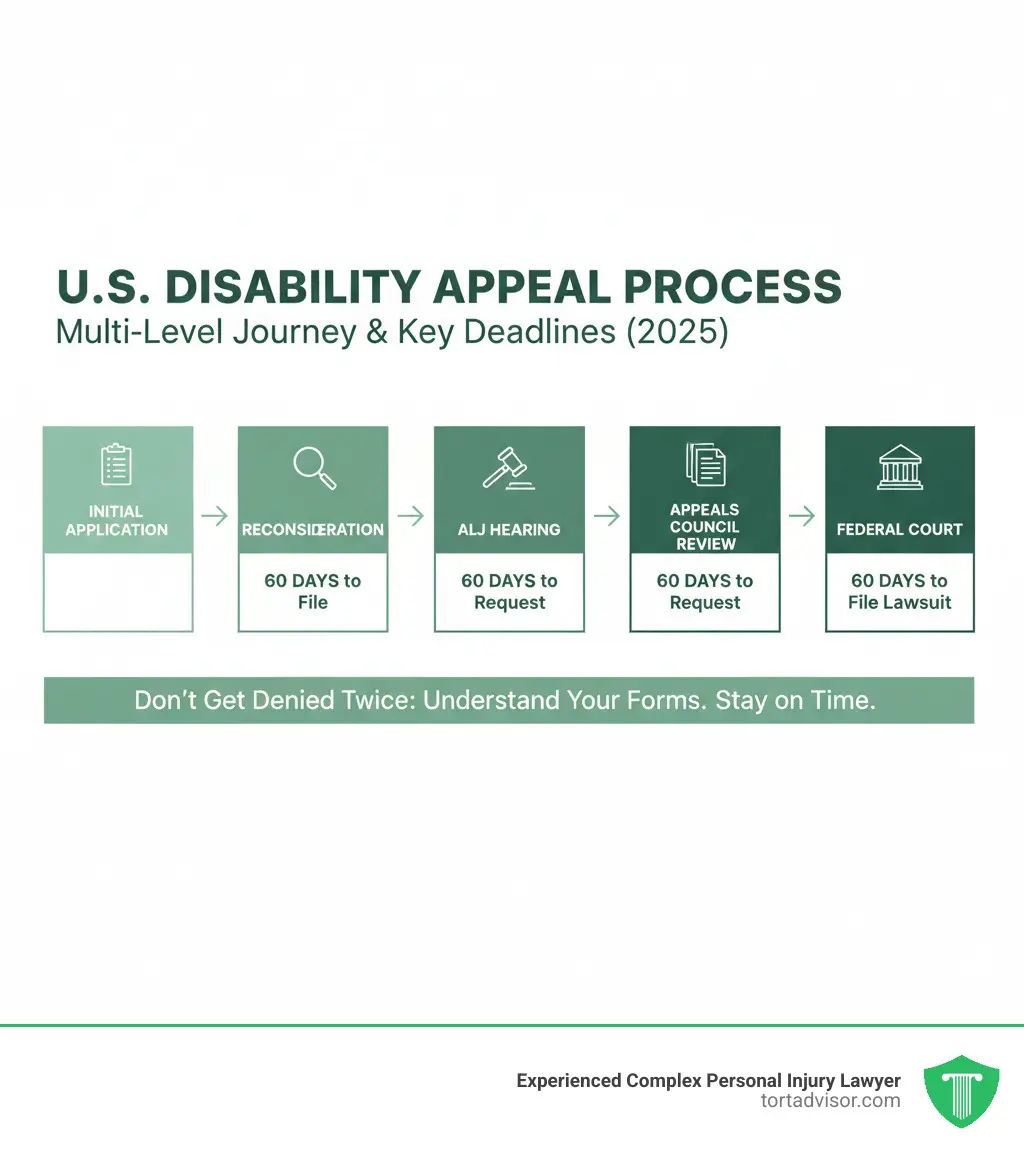


Why Mastering Your Disability Appeal Forms Can Change Everything
Disability appeal forms are the official documents you need to challenge a denied disability benefits claim. For those in the United States, you’ll primarily deal with the Social Security Administration (SSA).
| Agency | Key Forms for First Appeal | Where to Access |
|---|---|---|
| Social Security Administration (SSA) | Form SSA-561 (Request for Reconsideration) Form SSA-3441-BK (Disability Report – Appeal) Form SSA-827 (Authorization to Disclose Information) | SSA Forms Website or Appeal Online |
Getting denied for disability benefits is devastating. You’re already dealing with a health condition that prevents you from working, and now you’re facing a mountain of paperwork and strict deadlines.
But here’s the truth: most initial disability claims are denied. Statistics show that approval rates are significantly higher at the appeal stages, particularly during an Administrative Law Judge (ALJ) hearing.
That denial letter isn’t the end of your story. It’s the beginning of the appeals process—a multi-level system that many people win when they know how to steer it correctly. The key is submitting the right forms correctly and on time.
Missing a deadline—often just 60 days from your denial date—can mean starting over or losing your right to appeal entirely. Incorrectly filled-out forms can delay your case or lead to another denial.
This guide walks you through everything you need to know about disability appeal forms: which ones you need, how to fill them out, and how to strengthen your case with the right documentation.
Find more about Disability appeal forms:
Understanding the Core Elements of a Disability Appeal
A denial is often the starting line, not the finish line. The appeals process exists because initial reviewers can miss crucial medical evidence or misunderstand how your condition affects your daily life. Understanding the appeal levels can make the difference between giving up and winning the benefits you need.
The Journey Through Appeal Levels
In the United States, the appeal journey typically has four stages:
- Reconsideration: A new reviewer at the SSA re-examines your entire case file, along with any new evidence you provide. This is primarily a paper review.
- Administrative Law Judge (ALJ) Hearing: This is your opportunity to present your case in person to a judge. You can testify, bring witnesses, and answer questions directly. Approval rates are significantly higher at this stage.
- Appeals Council Review: If the ALJ denies your claim, you can ask the Appeals Council to review the decision for legal or procedural errors. They may uphold the decision, reverse it, or send it back for another hearing.
- Federal Court Action: The final step is filing a lawsuit in federal district court. This is a complex legal step for cases where you believe the law was improperly applied.
What Makes or Breaks Your Appeal
Across every appeal level, three elements determine success: strong medical evidence, supporting information, and meeting deadlines.
Your medical evidence is the foundation. It must show not just your diagnosis, but specifically how your condition prevents you from working. This includes detailed reports, test results, and statements from doctors describing your functional limitations (e.g., how long you can sit/stand, what you can lift, how your condition affects concentration).
Written statements from former employers, family members, or caregivers can add a powerful human element, describing your daily struggles and how your condition has impacted your abilities.
Deadlines are non-negotiable. In the US, you typically have 60 days (plus five for mailing) from your denial date to file an appeal. Your denial letter will state the exact deadline. Mark it on your calendar and treat it as the most important date in this process.
More info about what to do after a denied disability claim.
How to Fill Out and Submit Your Appeal
When completing disability appeal forms, be thorough. Start with your personal details (name, address, SSN) and information about the decision you’re appealing.
The most important section is where you explain why you are appealing. Be specific. Reference points from your denial letter and explain why the conclusions were wrong. Mention any new medical evidence you are including.
Signing and Submitting: For paper forms, sign with a pen. For electronic submissions, follow the agency’s instructions, which may allow for a typed name as a signature. You can typically submit forms via:
- Online Portals: The SSA’s online appeal system is often the fastest method.
- Mail: Use registered mail for a tracking number and proof of delivery.
- Fax: Keep the confirmation page as proof of transmission.
Always keep copies of everything you submit, including submission confirmations.
Formats and Accessibility
Disability appeal forms are available in different formats.
- HTML forms are web-based and ideal for screen readers.
- PDF forms can be downloaded, filled out on a computer (“fillable PDFs”), and then printed or saved. Use software like Adobe Reader for best results.
If you need an accommodation, such as a large-print form or an interpreter for a hearing, contact the agency directly. They are required to provide reasonable accommodations to ensure the process is accessible.
Navigating Disability Appeal Forms in the United States
In the United States, your disability appeal will be handled by the Social Security Administration (SSA), which oversees both Social Security Disability Insurance (SSDI) and Supplemental Security Income (SSI). The appeal process is the same for both programs.
The first step in the appeal process is the Request for Reconsideration.
| Agency | First Appeal Step | Key Form(s) | Where to Access |
|---|---|---|---|
| Social Security Administration (SSA) | Request for Reconsideration | Form SSA-561 (Request for Reconsideration) Form SSA-3441-BK (Disability Report – Appeal) Form SSA-827 (Authorization to Disclose Information) | SSA Forms Website or Appeal Online |
Key US Social Security Disability Appeal Forms
Knowing which disability appeal forms to use is critical. Here’s a breakdown of the essential forms for the initial appeal stages.
Form SSA-561, Request for Reconsideration: This is the form that officially starts your appeal. It tells the SSA you disagree with their decision and want a new review. You can often file this request for reconsideration online.
Form SSA-3441-BK, Disability Report – Appeal: This form updates the SSA on your medical condition since you first applied. You’ll detail new treatments, doctor visits, changes in your symptoms, and how your daily activities are affected. Be specific and thorough; avoid simply writing “no change.”
Form SSA-827, Authorization to Disclose Information: This crucial form gives the SSA permission to get your medical records directly from your doctors and clinics. Without it, they cannot gather the evidence needed to evaluate your claim. Submit a separate, signed form for each of your healthcare providers.
Form HA-520, Request for Review of Hearing Decision/Order: If an ALJ denies your claim, you file this form to ask the Appeals Council to review the judge’s decision. You must explain why you believe the ALJ made a legal or factual error.
All these forms are on the SSA Forms Website, and many can be submitted via the online appeal portal. Electronic submission is generally faster and provides immediate confirmation. For state-specific insights, see our guide on How to Claim Social Security Disability Insurance Arkansas.
What to Do If Your Disability Appeal Is Denied Again
Another denial letter is discouraging, but it’s not the end. Many successful claimants are denied multiple times before finally being approved. If your reconsideration is denied, your next step is typically an ALJ hearing, which offers a much higher chance of success.
What to Do First
Read the denial letter carefully. It explains why you were denied and gives you the information needed to strengthen your next appeal. Most importantly, it states your deadline to appeal again—do not miss it.
Gathering Additional Evidence
Focus on what’s changed since you last submitted your disability appeal forms. Have you seen new doctors, had more tests, or has your condition worsened? Ask your doctors for detailed statements about your functional limitations—what you can’t do because of your condition. A statement like “Patient cannot sit for more than 15 minutes and cannot lift more than 5 pounds” is far more powerful than “Patient has severe back pain.”
When to Seek Legal Guidance
If you haven’t already, now is the time to contact a disability attorney. Statistics consistently show that claimants with legal representation have significantly higher approval rates, especially at the ALJ hearing stage.
An experienced disability lawyer knows what judges look for, how to present medical evidence, and how to handle the complex rules and deadlines. Most work on a contingency fee basis, meaning they only get paid if you win your case from a percentage of your back pay, capped by law. You pay nothing upfront.
A Note About Long-Term Disability (LTD) Insurance
If you have a private LTD policy through an employer, its appeal process is separate from the SSA’s. These appeals involve the insurance company and are often governed by a complex federal law (ERISA). If your LTD claim is denied, it is highly advisable to consult an attorney who specializes in this area of law.
Don’t face another denial alone. The system is complicated, and the stakes are too high to steer without expert help.
Learn more about disability claim assistance
After a Successful Appeal: Managing Your Benefits
After months or years of fighting, an approval letter is a huge relief. But winning your appeal isn’t the final step. You need to understand how to manage your benefits to keep them.
Understanding Your Back Pay
When your appeal succeeds, you are entitled to back pay for the months you should have been receiving benefits. The amount depends on your disability onset date, your application date, and the type of benefit (SSDI or SSI). This is often paid as a lump sum, which can be a great help but may have tax implications.
Tax Considerations
A portion of your SSDI benefits may be considered taxable income, depending on your total household income. SSI benefits are not taxable. If you receive a large lump-sum back payment, it could affect your taxes for that year. It’s wise to consult a tax professional about how to handle this.
Continuing Disability Reviews (CDRs)
Receiving disability benefits doesn’t always mean you’ll have them for life. The SSA conducts periodic Continuing Disability Reviews (CDRs) to confirm you are still disabled. The frequency of these reviews depends on your age and whether your condition is expected to improve. You will be notified by mail and asked to provide updated medical information.
Can You Work While Receiving Benefits?
The SSA has work incentives that allow you to test your ability to work without immediately losing your benefits.
For SSDI, the Trial Work Period (TWP) allows you to work for up to nine months (not necessarily consecutive) while still receiving your full disability benefit, regardless of how much you earn.
After the TWP, you enter an Extended Period of Eligibility (EPE), a 36-month safety net where you can still receive benefits for any month your earnings fall below the “Substantial Gainful Activity” (SGA) level.
If your benefits stop because of work and you have to stop working again within five years due to your disability, you may be able to use Expedited Reinstatement to get your benefits started again without filing a new application.
When Do Disability Benefits End?
Your disability benefits will stop if a CDR finds you are no longer disabled, if you work and earn above the SGA limit, or when you reach full retirement age. At that point, your disability benefits automatically convert to retirement benefits.
If a benefit recipient passes away, their family should notify the SSA immediately to prevent overpayments. Family members may also be eligible for survivor benefits.
Frequently Asked Questions about Disability Appeals
The appeals process can be confusing. Here are answers to some common questions about navigating disability appeal forms and the process.
How long do I have to file a disability appeal?
Time is critical. In the United States, you generally have 60 days from the date you receive your denial letter to file an appeal with the Social Security Administration (SSA). The SSA assumes you receive the letter five days after it’s mailed, giving you an effective 65-day window. This deadline applies to each level of the appeal process (Reconsideration, ALJ Hearing, and Appeals Council). Your denial letter will clearly state your specific deadline. Missing it could force you to start over with a new application.
What happens after I submit my appeal to the Social Security Administration (SSA)?
After you submit your appeal forms, you’ll receive an acknowledgment from the SSA.
- At the Reconsideration stage, a new claims examiner will review your entire file, plus any new evidence you submitted. This is a paper review that can take several months.
- If you request an ALJ hearing, your case is sent to a hearing office. It can take many months, sometimes over a year, to get a hearing date. The hearing is your chance to testify before a judge.
- If you request an Appeals Council review, the Council will examine the ALJ’s decision for legal errors, not re-evaluate the evidence.
You can check your appeal status through your online My Social Security account or by calling the SSA.
Can I get help communicating with the Social Security Administration?
Yes, and it’s highly recommended. You have the right to appoint a representative to help you.
- A disability lawyer is your best option. They specialize in SSA law, know how to build a strong case, and can represent you at a hearing. Statistics show that claimants with legal representation have a much higher success rate. Most work on a contingency basis, so you pay no fees unless you win.
- Legal aid clinics may offer free or low-cost help if you meet their income requirements. You can search for legal aid in your area through resources like the Legal Services Corporation’s Find Legal Aid tool.
To appoint someone, you must file Form SSA-1696, Appointment of Representative, with the SSA. This gives your representative authority to communicate with the SSA on your behalf.
Conclusion
Navigating the disability appeals process is complicated. Between the multiple appeal levels, strict deadlines, and complex disability appeal forms, it’s easy to feel overwhelmed.
The most important thing to remember is that an initial denial is common, not the end of the road. Persistence and preparation are what separate successful claims from unsuccessful ones. Your chances of approval increase significantly when you appeal, especially with professional representation.
While this guide provides a foundation, every case is unique. You might be struggling to gather medical records or simply feel overwhelmed by the process while managing your health.
That’s where Tort Advisor comes in. We connect people like you with top-rated disability attorneys who have proven track records of winning appeals. They handle the paperwork, meet the deadlines, and build a compelling case so you can focus on your well-being. Most disability attorneys work on contingency, so you pay nothing unless you win.
You don’t have to steer this alone. Having the right legal guidance can make all the difference in your appeal.
Find expert legal help for your disability appeal
Free Confidential Case Evaluation
Complete the short form below to get an immediate FREE case review with an expert in your specific claim. Don't wait, your case could be time sensitive to file a claim.
Related Posts
Did a North Dakota product cause harm? Understand product liability, your rights, and how to take action for defects.
Get justice for clergy abuse. Find an expert Priest abuse lawyer to navigate complex laws and hold institutions accountable.
Diagnosed with meningioma after Depo-Provera? Understand potential Depo-Provera lawsuit settlements, risks, & how to claim compensation.
Uncover the truth about uber sexual assault cases. Learn about the alarming scale, Uber's accountability, and legal options for justice.
Facing wildfire losses? Discover the best wildfire lawsuit attorneys in California to fight for your full recovery and justice.
Exposed to Roundup & diagnosed with NHL? Discover how to sue Monsanto, understand eligibility, & seek compensation. Your guide to justice.





